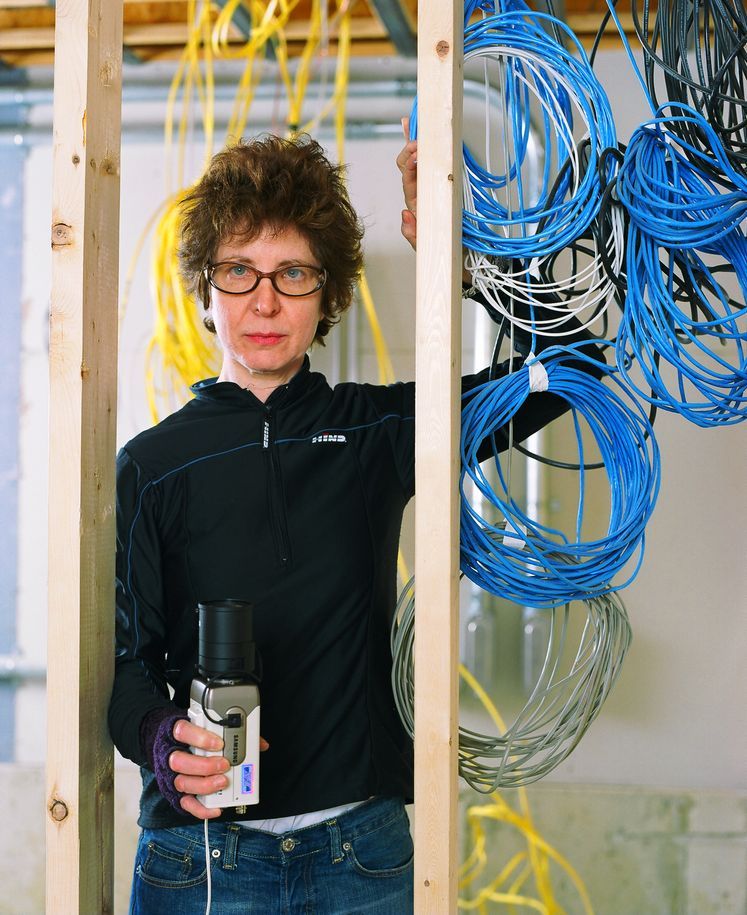 | American Nationality Born in 1954 in (United States) Lives and works in Cologne (Germany ) | Biographie Bibliographie Liste expositions |
 | American Nationality Born in 1954 in (United States) Lives and works in Cologne (Germany ) | Biographie Bibliographie Liste expositions |
Born in Hollywood, California in 1954, Julia Scher presently lives and works in Boston, where she teaches video in the Visual Arts department at the Massachusetts Institute of Technology. She has also taught at Harvard, Princeton and Rutgers Universities.
Through her video, sound and multimedia installations, as well as her performances and Internet projects, the artist analyses the structures of power, control and seduction, notably in the context of video surveillance and cyberspace. Taking a critical, ironic stance, she sets out the problems posed by surveillance systems and the ideology underlying them. As she has written, 'My work represents an attempt to design an active, multifaceted structure to investigate the fundamental premise that the technology of surveillance has evolved to such a level of effectiveness and persuasiveness that there is no sure way of knowing when we are actually being watched. If we assume that we are being observed at all times, there is no need for an overtly oppressive coercive mechanism of control. Surveillance becomes self-regulating and control is internalized.' [1]
Through her artistic practice, Scher attempts to make the viewer – and the citizen – aware of the dangers of the systems of control which, as they multiply and become omnipresent, constantly monitor the public space and, increasingly, the private space as well. In this context, her work may be associated with both the analyses of surveillance and power developed by Michel Foucault and George Orwell's fictional critique in 1984.
In parallel to this aspect of her work, Scher began to use internet as an artistic tool in the mid 1990s with Securityland (1995-1997). For Andrew Hultkrans, 'Scher is one of a number of emerging artists who deliberately misuse technology to expose its hidden ideological mechanisms. Demonstrating our complicity in the proliferating technologies used to survey both our physical and virtual identities, she toys with the notion of scopophilia, the cheap, reflexive thrill of looking. ... With its infinite links to packets of (potentially "dirty") data and its decentralized, labyrinthine design, the World Wide Web is an ideal medium for Scher. Indeed it might almost have been created by Scher herself, in her ongoing search for increasingly use-friendly surveillance systems that attract as they track.' [2]
Several of her works (such as Productive Engineering 2, 1998) combine video, computer programming and video surveillance equipment in order to recreate a control site within the museum itself. The museum architecture and the visitors thus participate in the elaboration of the works through a meticulous set-up which relies on digital video as well as internet or movement- and heat-detection systems. The combination of this set-up with real-time video retransmission, pre-recorded images and vocal commands reverses the principles of surveillance. Scher thus leads visitors into a voyeuristic world peopled by computer systems, cameras, monitors and automatic instruments. In this way, she explicitly makes them aware of the presence of all these devices and informs them of the uses and risks: the very systems created to ensure public safety can in reality threaten individual freedom: 'In my work, I generally don't modify the machines of control, but rather I modify the structure of implementation. For example, I use the exact same monitors and cameras used by official agents of security, but for radically different ends. The internalization of surveillance occurs in a variety of subtle, even insidious ways that are often resistant to linear analysis. A complex understanding (and possible naturalization) of surveillance/control dynamics requires a more experimental approach, therefore much of my work is designed to immerse one in multiple surveillance roles (viewer/subject; voyeur/exhibit; authority/target) in order to perceive surveillance from within.' [3]
In her work, Scher constantly plays with visitors, whether through the staging of public space (a museum with Vigilance, 1991, or Predictive Engineering 2, 1998) or that of private space (a bedroom with Always There, 1994, or Surveillance Bed, 1995). As a result, they are placed in a contradictory position, confronted by the voyeuristic pleasure of someone who observes the other but also by the pleasure of being observed and thus being the centre of attention. The artist thus stresses the contradictions involved in the everyday relationship to surveillance, which tends to be internalized and trivialized. Social control is a power which the citizen puts up with almost unconsciously.
Emilie Benoit
Translated by Miriam Rosen
[1] Artist's Statement, in The Art of detection, surveillance in society, List Visual Arts Center, Massachusetts Institute of Technology, Cambridge, Massachusetts, 9 October-28 December 1997.
[2] Andrew Hultkrans, Danger Dirty Data, Artforum, Sept. 1995, pp. 74-77.
[3] Julia Scher, Artist's Statement, in The Art of detection, surveillance in society, List Visual Arts Center, Massachusetts Institute of Technology, Cambridge, Massachusetts, 9 October-28 December 1997.